
Homogeneous Catalysis
.pdf
156 OTHER ALKENE-BASED HOMOGENEOUS CATALYTIC REACTIONS
a thermodynamic equilibrium over a catalyst, would have the concentration ratio of approximately 9:1.
7.7.3Catalytic Cycle for the Second Stage
As mentioned earlier, the first reaction in the second stage is the isomerization of 3PN to 4PN, reaction 7.18. The mechanism of this reaction is very similar to the mechanism of alkene isomerization discussed in Section 7.2.1, and shown by Fig. 7.14. The following points need attention.
The nickel–hydride complex that acts as a precatalyst for this isomerization reaction is thought to be the cationic part of 7.52. The evidence for the existence and participation of a cationic species such as 7.52 comes from multinuclear NMR and IR data. An equilibrium as shown by 7.23 exists, and the cation [HNiL4] is the dominant precatalyst for the isomerization reaction. The cation is an 18-electron complex. It undergoes ligand dissociation to give 7.53 before alkene coordination takes place. A ligand dissociated species such as 7.53 with L = p-tolylphosphite has been observed spectroscopically at low temperatures.
The isomerization of 3PN can lead to two possible products, 2-pentenenitrile (2PN), the unwanted isomer, and 4PN, the desired isomer. The former does not undergo hydrocyanation and thermodynamically is the most stable isomer. If the isomerization of 3PN were allowed to reach thermodynamic equilibrium, the concentrations of the three isomers 2PN, 3PN, and 4PN would be approximately 78:20:2. Fortunately the isomerization of 3PN to 4PN is about 70 times as fast as that of 3PN to 2PN. In other words, although 4PN is thermodynamically the less stable isomer, the favorable kinetics allows its preferential formation.
The catalytic cycle for the hydrocyanation of 4PN to desired adiponitrile and undesired 2-methyl glutaronitrile (MGN) is shown by Fig. 7.15. The intermediates that lead to the formation of 7.56 or 7.57 from NiL3 are not shown
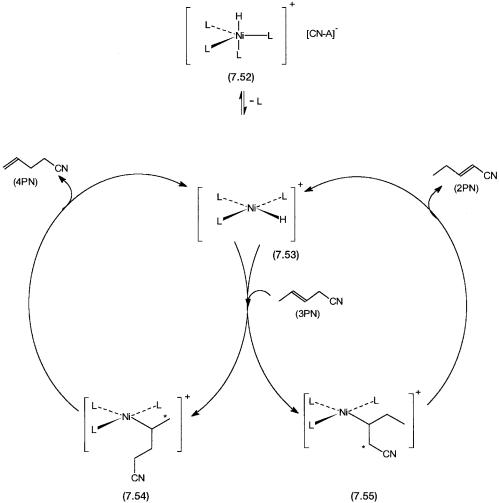
HYDROCYANATION 157
Figure 7.14 Second stage of hydrocyanation. Isomerization of 3PN to 4PN, the desired isomer, and 2PN, the unwanted isomer. The C atoms marked by asterisks are the ones from which the -hydride abstraction takes place.
but are considered to be 7.45 and 7.46, with the Lewis acid A attached to the coordinated cyano group.
The leftand right-hand loops of the catalytic cycle involves anti-Markov- nikov and Markovnikov additions, giving 7.56 and 7.57, respectively. The presence of the Lewis acid ensures that the former pathway is favored. Spectroscopic evidence for species 7.56 or 7.57 have so far not been reported. However, dissociation of two moles of ligand and involvement of the Lewis
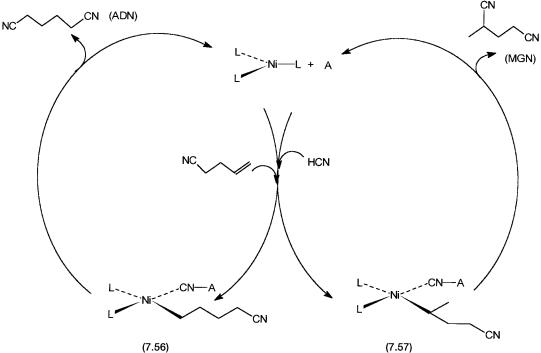
158
Figure 7.15 Second stage of hydrocyanation. Conversion of 4PN to adiponitrile (ADN) and MGN. A is the Lewis acid. The left loop dominates, giving ADN as the main product. Analogues of 7.45 and 7.46 with Lewis acid are not shown for clarity but are definitely involved.
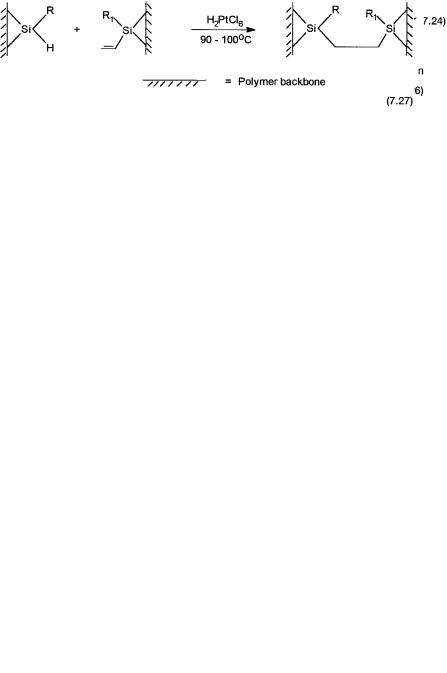
HYDROSILYLATION 159
acid in the transition state are indicated by the empirically determined rate law. This is shown by the following rate expression.
7.8HYDROSILYLATION
The addition of a silicon compound such as R3SiH to alkene functionality, as shown by reaction 7.25, is used widely in silicone polymer manufacture and is called the hydrosilylation reaction. Although hydrosilylation was discovered in 1947, the first homogeneous catalyst, H2PtCl6 (1–10%), in 2-propanol was reported in 1957 from the laboratories of Dow Corning.
The importance of hydrosilylation reaction in the context of homogeneous catalysis is twofold. First, the hydrosilylation reaction is very important in the “curing” of silicone rubber. Such curing leads to cross-linking of the polymer chains and turns a “syrupy” polymer to a “gum” rubber or a “soft” polymer to a “hard” one. Reactions 7.26 and 7.27 show the formations of new bonds that can bring about these changes in the polymer properties. Hydrosilylation reactions have also been used to give nitrile or a CF3 group containing monomers. These monomers in turn can be used to give silicone polymers of special properties.

160 OTHER ALKENE-BASED HOMOGENEOUS CATALYTIC REACTIONS
Second, the formal dividing line between homogeneous and heterogeneous catalysis becomes blurred in the case of hydrosilylation reactions. In a number of such reactions, recent evidence shows that metal colloids as well as homogeneous catalytic intermediates may be involved. The involvement of metal colloids is well established for all H2PtCl6 plus isopropanol-based reactions. Like the Zeigler catalysts, most of these catalytic systems are therefore closer to heterogeneous ones. In fact, even with fully characterized soluble platinum complexes of the type 7.58, under the conditions of the hydrosilylation reaction colloidal platinum is eventually generated. However, there is evidence to show that with these precatalysts mononuclear catalytic intermediates are also involved.
In reaction systems where the ligands prevent colloid formation, the hydrosilylation reaction probably occurs via true homogeneous catalytic intermediates. Many such systems, including one based on Wilkinson’s catalyst, have been reported. An interesting aspect of such reactions is that hydrosilylation of
—C—O and —C—N bonds could be effectively carried out. Such transformations may have potential applications in the syntheses of fine chemicals and intermediates.
7.8.1Catalytic Cycle and Mechanism
The first mechanistic proposal for the hydrosilylation reaction where mononuclear homogeneous catalytic intermediates are assumed is known as the Chalk–Harrod mechanism. The catalytic cycle in a slightly modified form is shown in Fig. 7.16. All steps of this catalytic cycle belong to organometallic reaction types that we have encountered many times before. Thus conversions of 7.60 to 7.61, 7.61 to 7.62, and 7.62 to 7.59 are examples of oxidative addition of HSiR3, insertion of alkene into an M–Si bond, and reductive elimination, respectively.
As already mentioned, the highly active hydrosilylation catalysts derived from H2PtCl6 has been shown to be colloidal in nature. Colloid formation from the precatalyst (COD)PtCl2 takes place according to reaction 7.28. This reaction obviously is not a stoichiometric one. The products cyclo-octene and cyclooctane are formed by hydrogenation of 1,5-COD catalyzed by the platinum colloid. The hydrogen generated in the reaction comes from the silane reagent.

C–C COUPLING AND CYCLOPROPANATION REACTIONS |
161 |
Figure 7.16 Proposed hydrosilylation mechanism with soluble catalysts of platinum or rhodium.
In recent years a variety of spectroscopic and other techniques have been employed to investigate and monitor hydrosilylation reactions. The techniques include multinuclear NMR, transmission electron microscopy, extended X-ray absorption fine structure (EXAFS), etc. Results from these experiments indicate that depending on the precatalyst, colloids and/or mononuclear complexes take part as catalytic intermediates.
7.9C–C COUPLING AND CYCLOPROPANATION REACTIONS
Soluble palladium complexes catalyze a large number of reactions of the type 7.29 and 7.30. These reactions are often referred to as Heck reactions. The precatalyst is usually PdL4 (L = PPh3) or a combination of Pd(OAc)2 with L. The base B could be organic or inorganic.
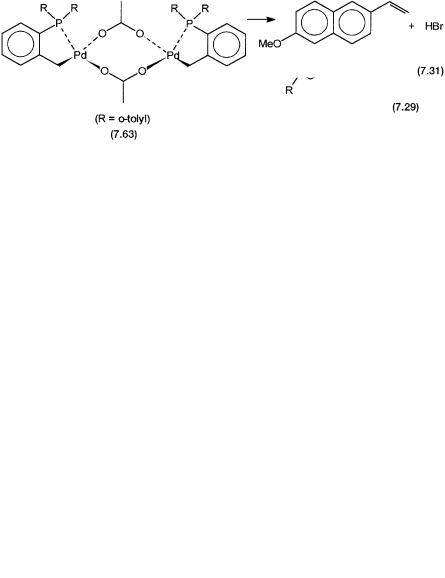
162 OTHER ALKENE-BASED HOMOGENEOUS CATALYTIC REACTIONS
Although these reactions are highly versatile, so far they have not found significant industrial applications. The main reasons for this are relatively low thermal stabilities and turnover numbers of the catalytic systems, and the salt waste problem. However, Hoechst is trying to develop an industrial process for the manufacture of 6-methoxy 2-vinylnaphthalene by reaction 7.31. The precatalyst used is the dimeric phosphapallada cycle 7.63, which operates below a pressure of 20 atm and temperature of 130 C.
Another variant of this type reaction has recently been utilized by Novartis to manufacture an intermediate for Prosulfuron (see Table 1.1). The synthetic scheme is shown by reaction 7.32. The soluble palladium-complex-catalyzed C–C coupling between a diazonium salt and a fluoro alkene gives the required intermediate. This is then converted to the final product by standard reactions of synthetic organic chemistry.
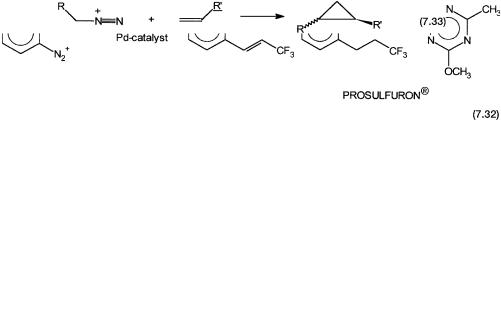
C–C COUPLING AND CYCLOPROPANATION REACTIONS |
163 |
Metal-catalyzed cyclopropanation of an alkene by a diazo compound, reaction 7.33, is another reaction where new C–C bonds are formed. This reaction finds use in the industrial manufacture of synthetic pyrethroids. The precatalysts for carbene addition reactions are coordination complexes of copper or rhodium. It should be noted that reaction 7.33 gives a mixture of isomers (syn plus anti) of the cyclopropane derivative. However, with some chiral catalysts, only one optical isomer with good enantioselectivity is obtained (see Section 9.5).
7.9.1Catalytic Cycle for the Heck Reaction
A general catalytic cycle proposed for Heck reaction is shown in Fig. 7.17. While all the steps in the catalytic cycle have precedents, the proposed reaction mechanism lacks direct evidence. The basic assumption is that under the reaction conditions, the precatalyst is converted to 7.64, a coordinatively unsaturated species with palladium in the zero oxidation state. Oxidative addition of ArX, followed by alkene coordination, leads to the formation of 7.65 and 7.66, respectively. Alkene insertion into the Pd–C bond followed by -H abstraction gives 7.67 and 7.68, respectively. Reductive elimination of HX, facilitated by the presence of base B, regenerates 7.64 and completes the catalytic cycle. The C–C coupled product is formed in the 7.67 to 7.68 conversion step.
There are two main uncertainties associated with this general mechanism. First, there are a number of C–C coupling reactions where there is no direct evidence for the reduction of the Pd(II) precatalyst into a zero-valent palladium species. Second, like the hydrosilylation system, a number of these reactions may involve colloidal palladium. Also, the general catalytic cycle needs to be substantially modified to rationalize the successful use of 7.63 as a precatalyst.
7.9.2Catalytic Cycle for Cyclopropanation
Two mechanisms have been considered for metal-assisted cyclopropanation of alkenes by diazo compounds. These are shown by reactions 7.34 and 7.35.

164 OTHER ALKENE-BASED HOMOGENEOUS CATALYTIC REACTIONS
Figure 7.17 Proposed mechanism for C–C coupling (Heck reaction). Direct evidence for the catalytic steps are lacking.
Reaction 7.34 involves a metal–carbene intermediate, while reaction 7.35 involves nucleophilic attack by the diazo compound to the coordinated alkene. With a rhodium–porphyrin catalyst direct spectroscopic evidence has been obtained for the carbene pathway (see Section 2.5.2).
The catalytic cycle proposed for the rhodium–porphyrin-based catalyst is shown in Fig. 7.18. In the presence of alkene the rhodium–porphyrin precatalyst is converted to 7.69. Formations of 7.70 and 7.71 are inferred on the basis of NMR and other spectroscopic data. Reaction of alkene with 7.71 gives the cyclopropanated product and regenerates 7.69. As in metathesis reactions, the last step probably involves a metallocyclobutane intermediate that collapses to give the cyclopropane ring and free rhodium–porphyrin complex. This is assumed to be the case for all metal-catalyzed diazo compound-based cyclopropanation reactions.
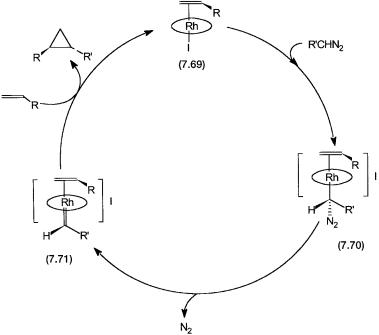
PROBLEMS 165
Figure 7.18 Catalytic cycle for the cyclopropanation of alkene by diazo compounds with a rhodium–porphyrin complex as the precatalyst.
PROBLEMS
1.In Figs. 7.1 and 7.2 identify oxidative addition, insertion, and reductive elimination steps. Show the formation of 7.7 from 7.6 by an electron pair (curly arrow) pushing formalism.
Ans. Fig. 7.1: no OA or RE, 7.2 to 7.3 insertion of alkene into M–H; Fig. 7.2: 7.6 to 7.7 OA, 7.7 to 7.5, RE. Reaction 7.1.
2.“The mechanism in Fig. 7.3 is applicable without modification for the hydrogenation of c-hexene, -acetamidocinamic acid, and styrene by Wilkinson’s catalyst.” Discuss the validity of this statement.
Ans. A number of the mechanistic steps are common, but the sequence of reactions and observable intermediates are different.
3.Do oxidative addition (OA) and reductive elimination (RE) reactions have to be present in the catalytic cycle for all metal-catalyzed hydrogenation reactions?
Ans. No. Other mechanisms (radical, heterolytic, etc.) may be available with transition metal complexes. With lanthanide complexes in the highly stable 3 oxidation state, an OA/RE-based mechanism is not possible.
